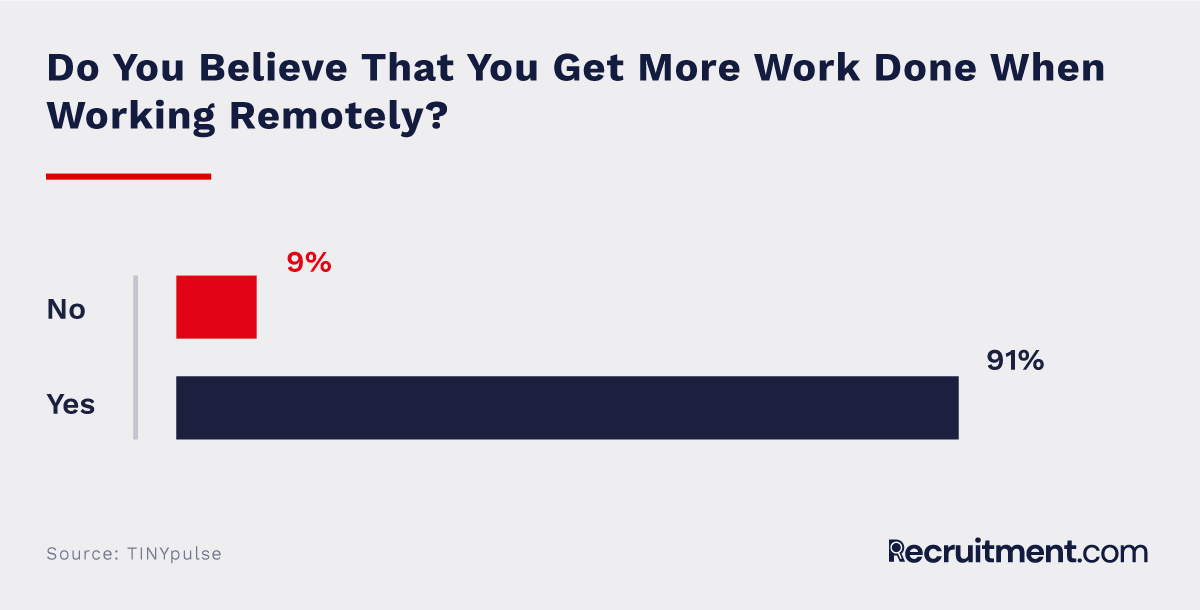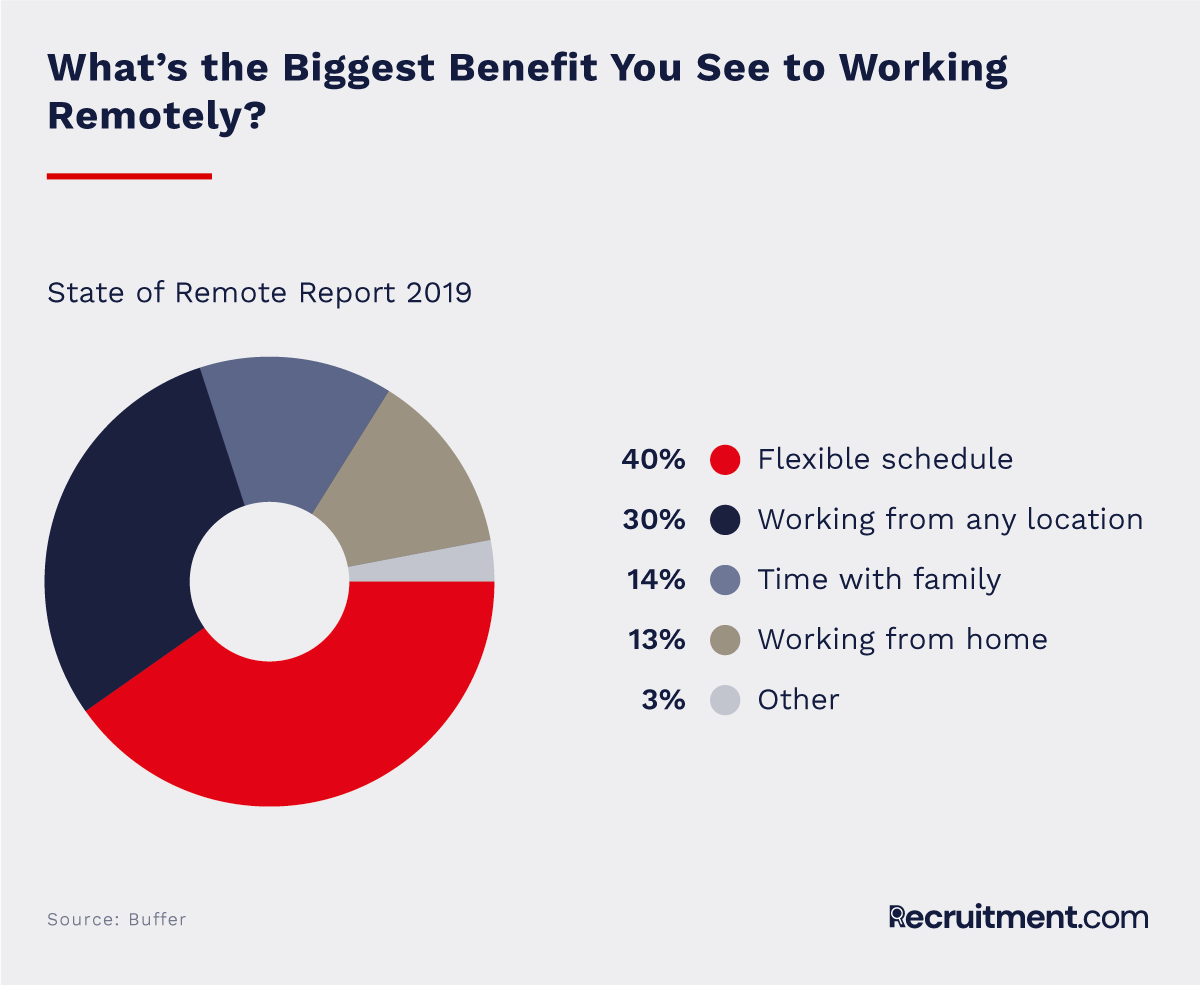The Benefits Of Working Remotely And Hiring Remote Employees

Sphoorti Bhandare has 10 years of experience writing about HR and technology.
Working remotely and virtual employment is here to stay. And companies that consider employees as their most significant asset are proactively working on establishing a remote work policy.
Everyone is going gaga over remote working.
They are not overreacting. Advanced technology and a growing need for autonomy among employees are pushing a transformational change in traditional work settings.
You can see the change happening already:
1. 18% of the global workforce works remotely
2. 95% of the respondents in a Zapier study noted they would prefer to work off-site
3. Gig employees are on track to grab a 50% share of the total US workforce by 2027
Just look at Buffer, Zapier, GitLab. These companies consist of 100% virtual employees.
Whether you plan to offer one-two remote positions or an entire virtual workspace, focus on creating a conducive company culture for remote work.
Plus, given that candidates and employees prioritize office culture over salary, starting a remote work program will test your willingness to: Upgrade your current workplace culture — irrespective of its success — to a remote-friendly one.
It is hard, but not entirely impossible.
How many types of flexible work arrangements are there?
- Remote work: Refers to employees working in any place or time zone
- Work from home (WFH): Refers to on-site employees working from home for certain events
- Telecommuting: Refers to employees working remotely in a specific region or zipcode (who come in for meetings occasionally)
A virtual work arrangement can be different for every company. So which one is right for you depends on:
- Your business and goals
- Your purpose for starting a remote work program
- Your employees' mindset on remote working
- The result you expect from such a program
Advantages Of Remote Work For Employers
The benefits of embracing remote work culture outweigh the negatives and may even become the deciding factor in how your business sustains.
Here are the most compelling positives you can see by enabling virtual employment.
Talent: You are not limited to geographical proximity anymore. With the booming gig economy, you can hire the best talent from any corner of the world. Your business can scale — up or down — with on-demand specialists and freelancers.
You can also attract high-quality candidates who otherwise may not have considered working at your company due to family obligations, expenses, and lifestyle changes.
There is more, according to Greg Heilers, Co-Founder of Jolly. He explains, "Your team spans multiple time zones, enabling a better coverage of vulnerable assets, quicker response time to clients, and more around-the-clock progress on projects."
Employee retention: Virtual work arrangements allow your mostly millennial workforce to travel, rejuvenate, and get back to work with a happier mindset.
Deloitte's Millennial Survey 2017 shows a strong link between remote work and better employee retention. Higher retention rate means lower employee turnover and fewer new (mis)hires.
Cost-effective: To run a physical office, you need to have a budget for:
1. Renting or buying a space
2. Installing amenities (kitchen appliances, computers, the Internet, printer, and more)
3. Paying utility and maintenance charges to keep the office running
With a partial or full remote workforce, you drastically bring down your costs. IBM, for example, saved more than $50 million in real estate expenses due to virtual work arrangements. The same Chinese travel agency mentioned above found it saved close to $2000 per remote employee.
Productivity and teamwork: Employees working within four walls can fall prey to distractions easily, wasting 23 minutes to get back to the task. They can even get pulled into office politics or face barrage of gossip in the kitchen.
Worse, they can feel more stress resulting in lower morale, productivity, and higher leaves. In fact, around 35% of full-time employees admitted to taking sick leave when they were just fine.
A team that's spread around timezones forces employees to overshare and take extra steps to be transparent about their day-to-day. "Remote workers stay productive when they manage their work," says Dominic Kent, Director of Content Marketing & Communications at Mio. "If you strip back the micro-managing, the set working hours, the constant checking in calls, and the needless 'meet-ups' to make you feel more of a team, you have a team of productive remote workers already."

Diversity: 56% of women leave a job in tech in the middle of their careers to look after the family. Technology hasn't necessarily wiped out patriarchal practices yet. It is still difficult for women and people with disabilities or religious beliefs to achieve complete independence.
Your company can give voice to such talented individuals with virtual employment.
Shiv Gaglani, Co-founder and CEO of Osmosis, says remote workers can also add "diversity of thought to our organization since the diaspora of teammates has different backgrounds in part due to their unique geographic experiences."
Advantages For Virtual Employees
Today's digital-savvy employees are aware and conscious about how they live their life, how their actions impact the Earth, and how they can create meaningful experiences.
And remote working gives them a chance to do all of the above and more.
What are the benefits virtual employees enjoy?
Flexibility: 40% of respondents said a flexible schedule was the biggest benefit of working remotely. Think about it.

They can choose where they work. Set a schedule that accounts for walks on the beach, visits to the gym, or meetings with friends. Take breaks that align with their natural rhythms. This level of flexibility can organically materialize into a balanced work and life approach.
Work satisfaction: Virtual employees do not have to get up at 5 am to get their kids ready, cook meals, drop their kids off, sit through standstill traffic, or slow public transit every day.
A 2016 TINYpulse survey found 509 full-time remote employees, when compared against benchmarks calculated from 200,000 employees working in various arrangements, felt more valued, productive, and happier.
Plus, remote workers are 87% more likely to love their job when they work from home, according to Mark Murphy of Leadership IQ.
Savings: Employees who choose to work virtually save costs on gas, meals, wardrobe, and public transit, totaling to $5000 or more.
Translation: They do not have to worry about eating outside, buying formal clothes regularly, or commuting. They can make a healthy meal and work in their pajamas instead.
Environmental impact: The lifestyle of remote employees can help reduce their climate footprint. Global Workplace Analytics states that if employees in a remote-friendly job decided to work virtually half the time, they would help save:
- 54 million tons of greenhouse gas
- 640 million barrels of oil
- 119 million miles of highway driving
Or in other words, the entire New York State workforce can permanently come off the road.
Is Remote Work a Selling Point for Recruiters?
Companies are warming up to remote work programs. 91% of business owners expressed they always wanted to support remote work.
But what about recruiters? Is it easier for them to design, implement, and promote a remote-friendly work opportunity?
The short answer is: Yes.
In a broader sense, however, the implementation of virtual employment starts with C-Suite and managerial buy-in.
Since today's employees expect a lot from their careers — such as work-life balance and remote work options — they also expect employers to lend a helping hand. In Buffer’s State of Remote Work 2019 report, 99% of respondents admitted they want to work remotely at least for a while during their careers. Let that number sink in.
Employees are telling companies they want more autonomy.
So, it is going to get harder for recruiters to find the right employees for on-site positions from a smaller candidate pool.
Offering remote positions shows current and future employees that you are investing in their growth just as much.
Dell started its Connected Workplace Program in 2009 and has since actively promoted virtual employment by:
- Highlighting inspiring stories of Dell employees who work remotely
- Sharing its journey toward a flexible work culture
- Establishing a Corporate Social Responsibility goal to encourage employees to use their various flexible work options
DigitalOcean, on the other hand, explicitly lists which locations and positions support remote work on its careers page.
What Are The Strategies For Implementing Remote Work?
It all begins by understanding that every business and its goals are different. And not all executives and managers may like the idea of remote work programs.
You can make an effort to change these perceptions by evaluating:
- Your goal in providing remote work
- Ways to align remote work culture to on-site practices
- Eligible positions for virtual work arrangements
- The positive impact of remote employees in boosting business revenue
Sidenote: If there are some positions you cannot offer remote options for, you can perhaps create a flexible schedule. For example, the employee can work Mondays to Thursdays and gets Fridays off, or she can come and go at suitable times during the week.
Next, draft a policy that includes:
- List of employees who will start working remotely
- Timeline for rolling it out throughout the company
- Communication etiquettes for:
- Sharing urgent information
- Building relationships
- Contacting supervisors
- Signing in and off for work
- Sharing feedback and concerns
- Virtual meeting instructions
- Work schedules to follow
- Accessible technology and tools
- Appropriate workflows for projects
- Guidelines for working in public spaces
- Precautions for secure exchange and storage of information
- Performance and productivity metrics
- Team-building activities
- Requirements for Wi-Fi networks and workspaces
- Regular check-ins via video
Remember: Technology has simplified how you engage and collaborate with your peers. But, there is one crucial drawback to using tools in remote working arrangements.
They cannot pick up conversational subtleties.
When employees work virtually, they cannot see the other person's face, catch their tone or expressions.
Chane Steiner, CEO of Crediful.com, adds, “Email is great for regular communications, but you need to know who you are talking to. So, take the time to talk with remote talent one on one via Skype or a phone call.”
This gap, if unattended, can quickly undermine your program.
Which Tools Are Valuable in A Remote Work Environment?
Remote work programs can be a welcome change for recruiters.
Besides widening their high-quality candidate pool, recruiters can also improve workplace engagement and satisfaction for employees of every kind. How?
With the help of software-as-a-service (SaaS) tools, of course.
SaaS tools facilitate virtual work with easy-to-use collaboration, communication, and feedback features with on-demand scalability.
And for many years, non-remote employees have relied on such tools to talk and share information with their workplace neighbors.
So, choosing and integrating different SaaS platforms should not be a hard task.
Based on your company, employee base, product/services, clients, communication etiquette, and legal policies, you can build an ideal remote work tech stack.
While you may use a few industry-specific platforms, here are the tools almost every company — with a big remote employee base — uses for better collaboration:
- Chatroom: Slack
- Video calling/conference meetings: Zoom/Skype/Google Hangouts
- Project management: Trello/Asana
- Document sharing/review: Google Docs (external)/Confluence (internal)
- Time tracking: Toggl/Hubstaff
- Automation: Zapier
- Tutorials: Loom
- Payroll: Gusto/Patriot/OnPay
- Expense tracking: Certify/Rydoo/Expensify
And if you plan to manage a remote software team, then using the following tools may prove helpful.
- Bug tracking: Planscope, App Trajectory, Pivotal Tracker
- Chatroom: FlowDock
- Project estimation: Planscope
Which Traits Make a Successful Remote Employee?
Remote working is a way of life.
So, the traits you find in an individual can help you determine whether he has the potential to be a productive, happy virtual employee.
What are the best qualities of a remote employee then?
1. Self-starter
2. Expert writer
3. Independent
4. Accountable
5. Trustworthy
6. Collaborative
7. Team player
8. Proactive
9. Curious
Besides, he should know how to manage his time and have a social support system.
A support system is vital because remote work isn't always picture perfect. It can undoubtedly cause loneliness, anxiety, or depression if the employee does not have dependable people in his circle.
Conclusion: Remote Work Programs Are Your Differentiator For Success
The success of your business may rely on your remote employees in just a few years. If you start drafting a plan now, you can run a trial program and develop it until you establish a robust flexible work culture.
This proactivity will not only help you eliminate talent crunch but also give your employees reasons to sing praises about you.
- Do you offer a remote work program?
- If so, what lessons did you learn along the way?

Sphoorti Bhandare has 10 years of experience writing about HR and technology.






